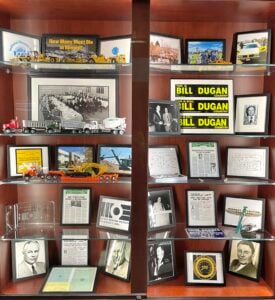
This display case is filled with Local 150 artifacts, photos, and memorabilia to illustrate the history of the union. The left side of the case is broadly devoted to labor management materials that illustrate the Midwest Operating Engineers trust funds, as well as Joint Labor Management Programs including the Indiana, Illinois, Iowa’s Foundation for Fair Contracting (IIIFFC) and the Chicagoland Operators PAC. The right side tells the story of the union. From bottom to top, it tracks the origin of Local 150 in 1929 through the various administrations of our President-Business Managers. Please read below to learn more about the contents of the shelves before you.
Above the Case
“The Safe Roads Amendment” yard sign promoted the signature achievement and culmination of the nearly century-old goal of creating a “lockbox” to fund transportation infrastructure. On November 8, 2016, Illinois voters overwhelmingly passed the Illinois Transportation Taxes and Fees Lockbox Constitutional Amendment, also known as the Safe Roads Amendment.
Top Right Shelf
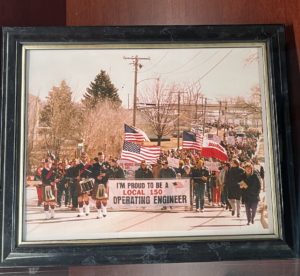
Top Right Shelf (1)
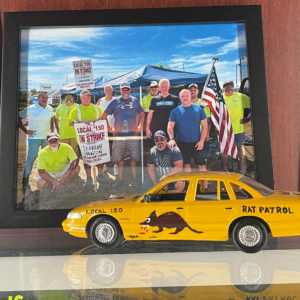
Top Right Shelf (2)
1) The Strike Against Lone Star Cement in Oglesby, Illinois, 1990. The parade protesting non-union construction is the first appearance of Scabby the Rat.
2) Material Producers Strike 2022. President-Business Manager James M. Sweeney visits picket line. Sweeney is the current President Business-Manager and has served since 2008. After winning election to the office in 2010, Sweeney has run unopposed in four straight elections, a Local 150 record.
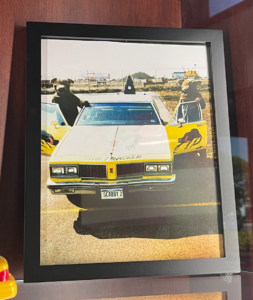
Top Right Shelf (3)
3) The photo on the right is of unidentified organizers in rat suits with rat car, circa 1989.
Second Shelf on the Right
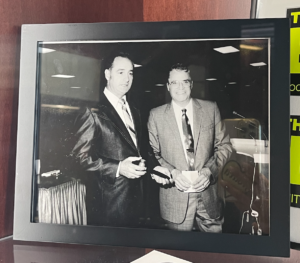
Second Shelf on the Right (1)
1) Photo on left is President-Business Manager William E. Dugan with Bill Martin. Dugan served as President-Business Manager from 1989 until his retirement in 2008 – a Local 150 Record 22 years. Under his leadership, Local 150 doubled its membership from about 10,000 in 1986 to over 22,000 members in 2008. Dugan’s many accomplishments include construction of Union halls in Districts 2, 3, 5, 6, and 7, as well as the Wilmington Training Center. As an Illinois Tollway Board member, Dugan implemented one of the region’s first Project Labor Agreements covering the Tollway construction work (1994). Dugan helped establish the Indiana, Illinois and Iowa Foundation for Fair Contracting (1999). He also established the Retiree Medical Savings Plan (RMSP) to subsidize retiree healthcare and eliminated Health and Welfare subsidy (2007); and established the Retirement Enhancement Fund (REF) to supplement members’ retirement (2008).
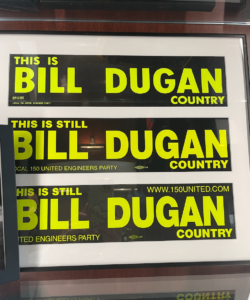
Second Shelf on the Right (2)
2) In the middle of the shelf are Campaign Bumper Stickers: “This is Bill Dugan Country” original in 1986; “This is Still Bill Dugan Country” reelection campaign 1989; “This is Still Bill Dugan Country” with website, reelection campaign in 2007.
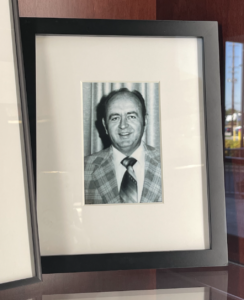
Second Shelf on the Right (3)
3) The photo on the right is of President-Business Manager Thomas T. (“Tom”) Rodd, who served from 1983 to 1986. Tom Rodd had the unfortunate task of negotiating Local 150’s major construction agreements during the severe recession of 1983 through 1984. That year, the Union distributed rings of cheese to out-of-work members. Concessions in the 1984 Agreements likely led to Rodd’s defeat by Bill Dugan in the hotly contested election of 1986.
Third Shelf on the Right

Third Shelf on the Right (1)
(1) This shelf depicts the merger of Local 150 with IUOE Local 537, which had Hoisting and Portable jurisdiction over the Illinois and Iowa region known as the “Quad Cities” straddling the Mississippi River (Bettendorf and Davenport, Iowa, and Moline and Rock Island, Illinois). In 1991, Local 537 Business-Manager Jack Shadt approached Bill Dugan about a merger with Local 150 in order to strengthen his 1,000-member local. Following the practice pioneered by John Maloney, Dugan kept the Local 537 Officers on as Business Agents to service the newly created Local 150 District 8.
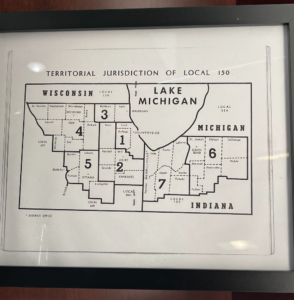
Third Shelf on the Right (2)
(2) The map on the right depicts the geographic jurisdiction of Local 150 in 1991, prior to the merger. The Local 150 Engineer in the center of the shelf published June 1991 announces the merger. The map on the left depicts the geographic jurisdiction of Local 150 after the merger. The framed union buttons are the quarterly Local 537 buttons issued the last year of its existence.
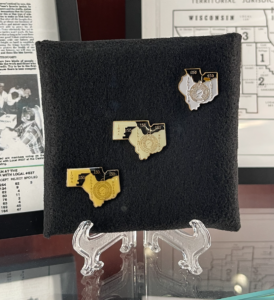
Pre- and Post-Merger Lapel Pins
(3) The lapel pins show Local 150’s geographic jurisdiction pre- and post-merger.
Fourth Shelf on the Right
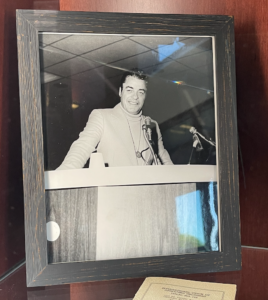
Fourth Shelf on the Right (1)
1) This shelf depicts specific accomplishments of President Business-Manager William F. “Bill” Martin. Martin served from 1962 until his retirement in 1983. Martin started the monthly publication of the Local 150 Engineer (1962) (that first volume is mounted on the wall next to the elevator, dated July 1962). His many accomplishments included negotiation of landmark Collective Bargaining Agreements after a 50-day strike in 1966 in the construction industry which established the Pension Fun, and the Apprenticeship Program in 1969 and many of the work rules like overtime after eight hours. Martin built the original Union Hall in Countryside, Illinois, as Local 150’s main headquarters in 1969. Local 150 struck Chicago-area contractors again in 1981. The strike ended shortly after Martin’s home in suburban DuPage County mysteriously blew up.
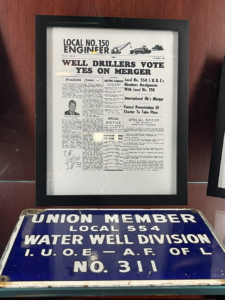
Fourth Shelf on the Right (2)
2) In 1967, Martin accomplished the merger of Local 150 with the IUOE Well Drillers Local 554. The October edition of the Local 150 Engineer announced the merger, which is in the center of the shelf . Below the Engineer is an original metal plate that was attached to a drill rig identifying it as operated by an IUOE 554 member.
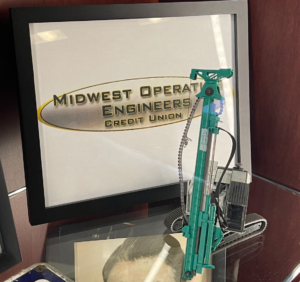
Fourth Shelf on the Right (3)
3) To the right of the shelf is a die-cast drill rig. Behind the model rig is the logo of the Midwest Operating Engineers Credit Union, which was established during Bill Martin’s tenure in 1974.
Bottom Shelf
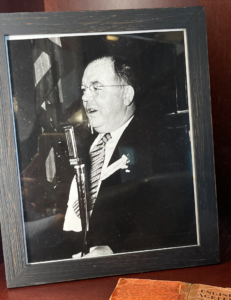
Bottom Shelf (1)
1) The photo on the left is of Local 150’s first President-Business Manager, William E. Maloney. After the amalgamation of exiting Chicago locals in 1929 described below, Maloney was appointed the “supervisor” of the newly chartered Local 150. He served as Local 150’s President-Business Manager from 1929 to 1940. In 1940, Maloney was named General President of the International Union of Operating Engineers, the first of only two Local 150 members to serve as a top officer of the IUOE, the other being Jim Sweeney, General Secretary and Treasurer.
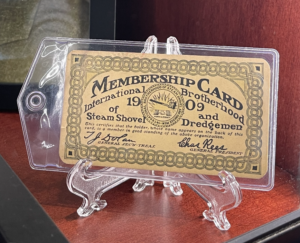
Bottom Shelf (2)
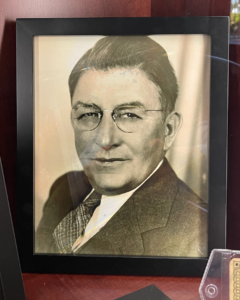
Bottom Shelf (3)
2) Like many unions in the United States, the International Union of Steam Operating Engineers in the early 20th Century was a collection of small local unions with jurisdiction in a single industry in a limited geographic area. In 1929, the IUOSE ordered two Chicago locals to “amalgamate:” Local 569, the hoisting and portable local, and Local 42, the steam shovel local, combined on May 8, 1929, to form Local 150. The next year, 1930, IUOE Local 464, the Chicago street pavers local, voted to join Local 150. The union membership card is that of the dredgemans local. The Local 464 buttons are a few of the last issued by the pavers local.
3) The photo on the right is of John L. Lynch, who served as Local 150’s President-Business Manager from 1940 until 1952.

